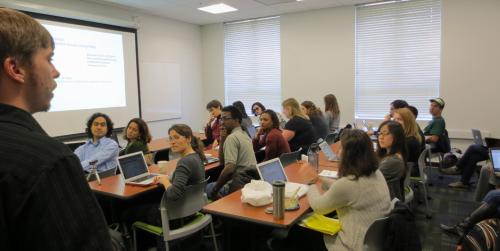Creating Collaborative Data Space: a Profile of the New Social Sciences Data Laboratory

Why write about a social sciences data laboratory on a humanities blog?
Looking at lists of Berkeley departments and programs in the Humanities and in the Social Sciences, we might wonder why History is in the social sciences division, while the History of Art is in the humanities; why Anthropology is a social science department, while Ancient History and Mediterranean Archaeology is a humanities program; why Linguistics is not found in the same division as English, Slavic, Chinese, French, German, Japanese.... From the outside, such distinctions can be invisible. For undergraduates in engineering, for instance, all of those different fields are lumped together into one “breadth” requirement, often referred to simply as H/SS. There are reasons for all of this, I’m sure. But are they good ones? I won’t dare answer that question here.
Nevertheless, we might think of several generations of anti-positivist and postmodern scholars who have questioned the nature of the social sciences, asking, "just how scientific are they?" And more recently, some literature scholars have sought to put their fields on a more empirical foundation using digital methodologies (that is, by quantifying and measuring text, and by testing and verifying conclusions). The Townsend Center has stressed interdisciplinarity through its core programs for years, and interdisciplinary programs have been a prominent feature of undergraduate education for at least two decades. Many of these trends have brought plenty of controversy. Yet, from where I sit, it looks as though the social sciences and the humanities—or at least certain segments among them—are closer together, in methods and in theory, than they have been for a long time, and disciplinary boundaries are perhaps fuzzier than our institutional structure would suggest. As we move forward, it is possible that digital methods and data analysis will have a role to play in all of this.
This is why the new Social Sciences Data Laboratory (D-Lab) is an appropriate topic for a humanities blog, and why, as a digital humanities blogger, I am excited by what is being done there. (In the interest of full disclosure, I should say that in my capacities as Digital History Coordinator, I have been working closely with D-Lab from the beginning, but nonetheless). D-Lab has emerged to meet an important need: that of researchers to keep apace of rapidly changing technologies of data or information.
D-Lab was created following a report from the office of the vice chancellor for research Graham Fleming, which called for a more dynamic and flexible laboratory-based approach to social science research, amid the university-wide reorganization stimulated by recent losses in state funding. Led by historian of science Cathryn Carson, Associate Dean of the Social Sciences, D-Lab results from a reorganization of several groups, including UC Data, an archive and a provider of large-scale databases that was formerly part of the Survey Research Center that closed in 2010, and elements of the Social Science Computing Laboratory, a computing facility which dealt mainly with survey data.
This is more than just an institutional shuffle. In order to meet new technological and research demands that senior faculty do not always understand, D-Lab has taken a start-up approach, heavily involving graduate students at every stage of the process. Dean Carson commented on this approach in a D-Lab blog:
This isn’t always how Berkeley has operated. We are betting we can institutionalize this kind of responsiveness, even in the middle of the university’s long-established structures. We partly look outside for models—for fluid, adaptable organizations in the social and private sectors that are attentive to fitting into a scene that is constantly in flux. We also look inside. One thing crystallized out of the D-Lab design process: Berkeley’s graduate students are vastly talented and incredibly inventive. They are D-Lab’s first target audience, as well as the core of our start-up team.—Cathryn Carson, D-Lab as a Start-up
Only time will tell whether this graduate-student led, start-up style research institute is successful, but the early signs are promising. In the two months since it opened, the workshops have been frequent and well-attended, drawing faculty, staff, and librarians, as well as graduate students. And a core community of graduate student researchers is growing up in the space.
In the context of a certain amount of convergence among the various disciplines of the humanities and social sciences, rather than challenging institutional boundaries, D-Lab takes an agnostic approach. Attending a D-Lab event, you will hear this in their introduction: “D-Lab is about social sciences and data, but it polices the boundaries of neither.” This theoretical and disciplinary agnosticism is intended to keep D-Lab flexible and responsive to the emerging needs of researchers in a computing society, for whom the current disciplinary boundaries, both in and between the humanities and the social sciences, may not be so helpful for engaging with data.
On April 23, D-Lab will participate in "What Can Digital Humanities do for You?" co-sponsored by the Office of the Dean of the Arts and Sciences, The Townsend Center, the Berkeley Center for New Media, and Berkeley IS&T. The event will be followed by D-Lab's end of the semester celebration, "Opening the Black Box."